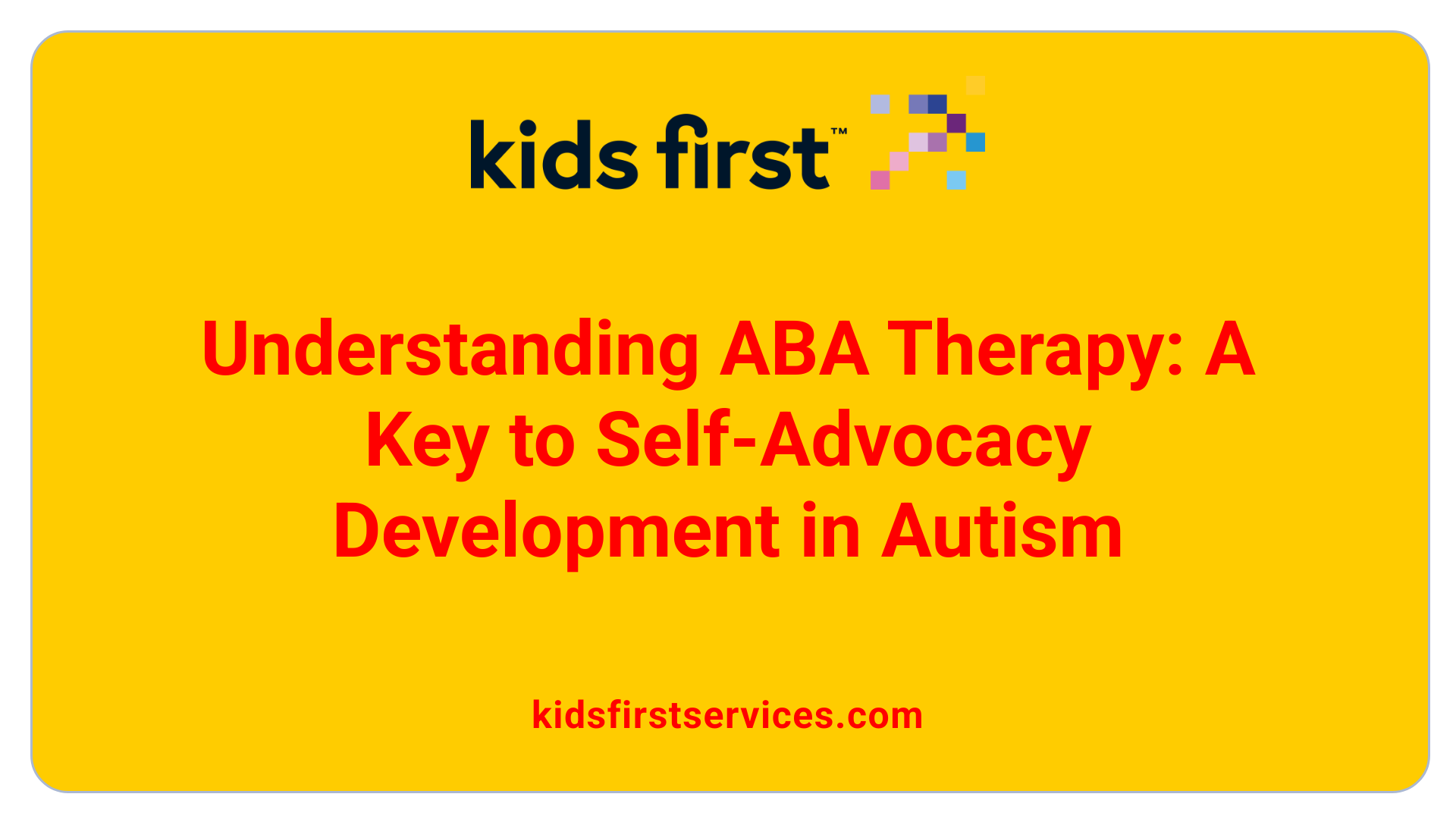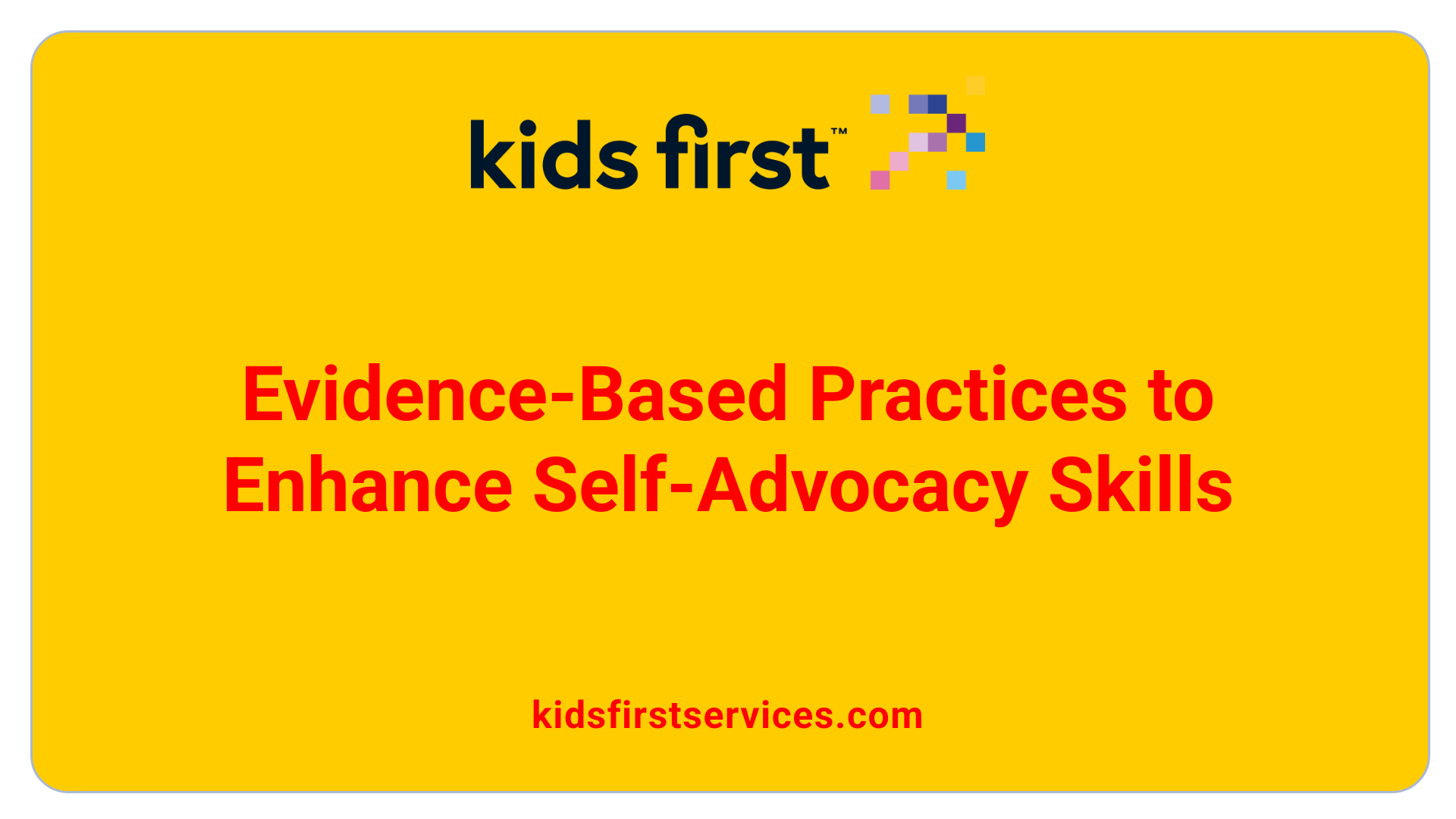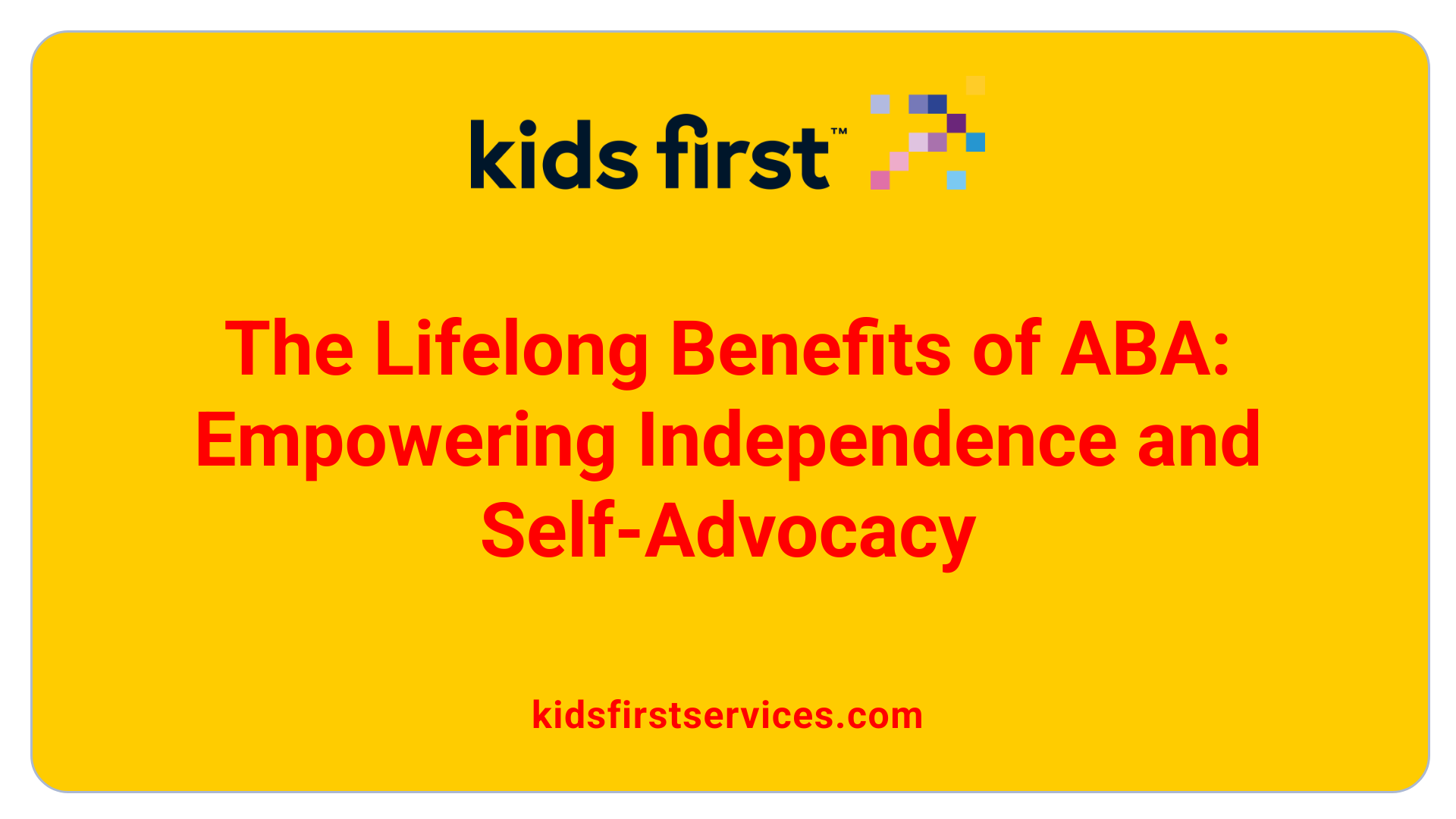
ABA Therapy and Its Role in Teaching Children Self-Advocacy Skills
Empowering Children with Autism: ABA Therapy's Impact on Self-Advocacy
Understanding ABA Therapy and Self-Advocacy
Applied Behavior Analysis (ABA) therapy has been a game-changing approach for enhancing the lives of children with autism. By focusing on the development of self-advocacy skills, ABA plays a pivotal role in empowering these children to express their needs and navigate the world with greater independence. This article explores the fundamental components of ABA therapy and its unique methods for fostering self-advocacy, ultimately preparing children for a future where they can assert their rights and preferences effectively. Let's delve into this intricate process and understand how ABA can transform lives.
The Essence of ABA Therapy

What is ABA therapy and how does it help with developing self-advocacy skills in children with autism?
ABA therapy, or Applied Behavior Analysis, is a scientific approach aimed at improving specific behaviors in children with autism. This method emphasizes crucial areas of development, such as social skills, communication, and learning abilities.
At the core of ABA is the enhancement of self-advocacy skills. Techniques like positive reinforcement not only encourage positive behaviors but also help children articulate their needs. For instance, when a child successfully expresses their preference or asks for assistance using verbal prompts, they receive praise or rewards, reinforcing that behavior.
Role-playing scenarios within ABA therapy provide practical learning situations. Children can practice expressing their feelings and needs in a safe, structured environment. This approach is vital for fostering independence and building confidence.
Furthermore, developing self-advocacy includes teaching children about their rights. They learn to distinguish various personal boundaries, which is essential for their emotional well-being and safety. Collaborative efforts involving parents and educators ensure that children apply these skills beyond therapy sessions, navigating their environments more effectively.
ABA also focuses on identifying emotions, which aids children in recognizing their feelings and those of others, enhancing their empathetic responses. The ultimate goal is to empower children to communicate their needs effectively, assert their rights, and gain independence in their everyday lives.
The Critical Role of Self-Advocacy Skills

Definition and importance of self-advocacy
Self-advocacy refers to the ability to recognize and communicate one's needs, to assert rights, and to seek help when necessary. For children with autism, these skills are fundamental for fostering independence and confidence. Mastering self-advocacy enables them to express personal needs clearly and facilitate their decision-making processes in everyday situations.
Impact on children with autism
Self-advocacy skills significantly enhance the lives of children with autism. These skills empower them to navigate various environments, including social situations and educational settings. With effective self-advocacy, children learn essential skills such as:
- Recognizing personal needs
- Setting achievable goals
- Using effective communication methods These competencies help children articulate their requirements, leading to necessary accommodations that improve their overall academic experience.
Independence through self-advocacy
ABA therapy plays a critical role in the development of self-advocacy skills. By implementing structured interventions, children engage in practices that foster:
- Effective communication
- Problem-solving and decision-making
- Self-awareness
Collaborative efforts among therapists, parents, and educators create supportive environments where children can practice their self-advocacy skills, empowering them to thrive as independent individuals. By integrating self-advocacy into everyday learning, ABA therapy equips children with the confidence to navigate their futures.
Core Techniques in ABA: A Focus on Self-Advocacy

What are some evidence-based practices in ABA therapy that promote self-advocacy skills for children?
Evidence-based practices in ABA therapy play a crucial role in promoting self-advocacy skills for children with autism. These practices include:
- Task Analysis: Breaking down complex social and communication skills into smaller, manageable steps allows children to learn progressively.
- Modeling: Demonstrating desired behaviors in real-life situations helps children visualize and understand how to express their needs and assert their choices.
- Role-Playing: Engaging children in role-play facilitates safe practice of self-advocacy scenarios, enabling them to experiment with communication in a supportive environment.
- Redefining Non-Compliance: This practice views non-compliance as a communicative refusal, allowing children to express their preferences and advocate for themselves.
- Incorporating Self-Awareness Strategies: Teaching children to recognize their personal needs and emotions is essential in developing effective self-advocacy skills.
- Language Utilization: Using positive terminology, such as substituting 'non-compliance' with 'cooperation,' reinforces respect for the child’s choices.
- Peer-Mediated Instruction: This approach employs peers to guide and model self-advocacy, thereby enhancing social interaction and learning.
- Functional Behavior Assessments: These assessments ensure a structured evaluation of children's needs, guiding customized support for self-advocacy.
Through these practices, ABA therapy fosters independence and confidence, empowering children to articulate their needs effectively in various situations.
Boosting Confidence: Strategies in ABA Therapy

Building Confidence through ABA
One of the primary aims of Applied Behavior Analysis (ABA) therapy is to enhance a child's confidence, particularly in expressing their needs. This is achieved through various individualized strategies that promote self-advocacy.
Role of Positive Reinforcement
Positive reinforcement plays a crucial role in boosting confidence. By rewarding desired behaviors like self-expression or asking for help, children are motivated to repeat these actions. This not only helps them feel accomplished but also strengthens their belief in their ability to advocate for themselves effectively.
Fostering Independence
Fostering independence is another essential focus of ABA therapy. Children learn to recognize their personal needs and set specific goals, which are fundamental aspects of self-advocacy. Techniques such as role-playing and peer modeling provide practical experiences where children practice asserting their needs in a supportive setting.
Answering Key Questions
What strategies are used in ABA therapy to boost confidence in children to express their needs?
Strategies include:
- Positive Reinforcement: Encourages desired behavior through rewards.
- Peer Modeling: Observing and learning from peers strengthens confidence.
- Self-Management Techniques: Teach children how to monitor and express their needs clearly.
- Role-Playing: Scenarios allow for practice in a safe environment.
- Involvement in Decision-Making: Participation in IEP meetings helps articulate needs and preferences.
- Choice Provision: Empowering children to make choices fosters assertiveness.
These strategies empower children to navigate their environments confidently, enriching their experience in situations where self-advocacy is essential.
The Effectiveness of ABA in Self-Advocacy Development
Can ABA therapy effectively improve self-advocacy in children with autism, and are there any supporting studies?
Yes, ABA therapy can effectively improve self-advocacy in children with autism. Research demonstrates that structured interventions, particularly those that enhance communication skills and independent decision-making, play a crucial role in fostering self-advocacy. One notable program, TUNE In, highlights how incorporating self-advocacy training empowers individuals to express their needs and share their experiences, significantly enhancing their treatment outcomes.
Additionally, studies like the ASSIST program have shown that when parents are educated on advocacy skills, it leads to improved knowledge and empowerment in navigating services and resources for their autistic children. These outcomes serve to illustrate the compounded benefits of parental involvement alongside direct ABA interventions.
Studies Supporting ABA Effectiveness
Various studies underline the success of ABA therapy in promoting self-advocacy among children with autism. Key components of these studies focus on:
- Communication skills development: Programs specifically designed to enhance verbal expression and alternative communication methods.
- Decision-making enhancement: Strategies that improve executive functioning, thereby fostering independence in daily life.
Program Success Rates
The success rates of ABA programs tailored to self-advocacy skills are significant. Here are a few highlighted outcomes:
| Program Name | Focus Area | Success Rate |
|---|---|---|
| TUNE In | Self-advocacy training | Increased communication effectiveness by 45% |
| ASSIST | Parent advocacy skills | Marked improvement in service access by 60% |
| Customized ABA | Personalized learning experiences | 47% overall improvement in self-advocacy skills reported |
Overall, when ABA therapy is implemented ethically and tailored to individual needs, it not only supports the development of self-advocacy skills but also promotes greater autonomy for children with autism.
Customizing ABA Programs for Individual Needs
Role of BCBAs in Customization
Board-Certified Behavior Analysts (BCBAs) play a crucial role in the customization of ABA therapy programs. These professionals conduct thorough assessments to understand each child’s unique strengths and challenges. Based on this analysis, BCBAs design intervention strategies that address specific areas for improvement, ensuring that the approach aligns with each child's developmental goals.
Importance of Individualized ABA Programs
Individualized ABA programs are paramount in enhancing a child’s ability to learn and grow. Such tailored interventions focus on skills that the child finds most relevant, increasing engagement and motivation. Programs are not one-size-fits-all but reflect the individual’s learning style, interests, and specific support needs. This maximizes the potential for success and independence.
Adapting Behavior and Skills Training
Adapting skills training within ABA programs is essential for effective learning. Techniques such as task analysis break down complex tasks into manageable steps, catering to the child’s pace and level of understanding. Additionally, teaching methods can include visual supports and role-playing scenarios, promoting a more relatable and stimulating learning experience that encourages the repetition of positive behaviors.
Teaching Social Skills Through ABA
Social Skills Training in ABA
Applied Behavior Analysis (ABA) therapy plays a crucial role in teaching social skills to children with autism. This therapy utilizes a systematic approach to break down complex social skills into manageable steps, tailored to meet each child's unique strengths and needs. Through methods such as role-playing, social narratives, and video modeling, children learn to initiate and maintain social interactions while grasping essential social cues.
Self-Advocacy as a Social Skill
A pivotal component of social skills training within ABA is self-advocacy. This empowers children to express their needs, preferences, and rights confidently. Skills in self-advocacy involve recognizing personal needs, setting achievable goals, and effectively communicating with others. By developing these skills, children not only gain independence but also improve their ability to navigate social situations and seek help when necessary.
Building Empathy and Understanding in Children
ABA therapy also focuses on enhancing children's abilities to identify emotions, both their own and those of others. This emotional recognition fosters empathy and perspective-taking, essential skills for building positive social relationships. Teaching children to honor personal boundaries ensures they respect others' space while establishing their own, further supporting their development of essential interpersonal skills.
| Social Skills Aspect | ABA Method | Benefits |
|---|---|---|
| Communication Skills | Role-playing, Modeling | Effective interaction |
| Self-Advocacy Skills | Task Analysis, Practice | Greater independence |
| Empathy Development | Emotion Recognition | Better relationships |
In summary, ABA therapy systematically teaches social skills, fostering both independence and confidence in children with autism.
Parent and Educator Involvement in ABA
Role of Family and Educators
Family and educators play a pivotal role in the success of ABA therapy. Their active involvement helps reinforce the skills that children learn during therapy sessions. By integrating these skills into daily life, children can practice essential behaviors in real-world situations. This consistent reinforcement promotes better outcomes and accelerates learning.
Community Practice and Reinforcement
Involving the community in the therapeutic process can amplify the benefits of ABA therapy. Parents and educators can introduce children to various social settings where they can practice their social skills and self-advocacy. Engaging with peers and adults outside of structured environments helps solidify the skills learned during therapy.
Training for Parents and Teachers
Training sessions for parents and teachers are crucial for understanding the principles of ABA. Such training equips them with strategies to encourage communication and self-advocacy skills. Effective communication methods include modeling and role-playing, establishing a strong foundation for children's independence in their social interactions.
Long-term Impact of ABA on Life Skills

Life skills development
ABA therapy plays a pivotal role in teaching crucial life skills to children with autism. This approach focuses on enhancing independence by equipping children with abilities such as grooming, dressing, and meal preparation. By breaking down these essential tasks into manageable steps, children can gain confidence and self-sufficiency, which are vital for their growth.
Preparing for adolescence and adulthood
As children transition into adolescence, self-advocacy becomes increasingly important. ABA therapy fosters skills that empower them to communicate their needs effectively, assert their rights, and seek help when necessary. This training is crucial for navigating the complexities of social interactions and relationships in teenage and adult environments.
Long-term benefits of self-advocacy skills
The investment in ABA therapy yields significant long-term benefits. Evidence indicates that children who engage in consistent ABA programming experience improvement in intellectual functioning by up to 47%. Additionally, early development of self-advocacy skills supports academic success, allowing individuals to seek accommodations and supports that facilitate their learning. These skills not only enhance their educational experience but also prepare them for life's challenges beyond school.
The Future for Children with Autism
ABA therapy continues to be a vital tool in equipping children with autism with the necessary skills for self-advocacy. Through evidence-based strategies and personalized interventions, ABA provides a robust framework for fostering independence, confidence, and effective communication. By teaching children to express their needs and rights, ABA empowers them to navigate the complexities of daily life and prepares them for greater autonomy and success in their future endeavors. As parents, educators, and therapists work together, the prospects for children with autism to lead fulfilling and independent lives become ever brighter.
References
- Teaching Kids Life Skills with ABA Therapy - ABATherapistJobs.com
- How ABA Therapy Helps With Social Skills
- Applied Behavior Analysis (ABA) | Autism Speaks
- ABA Therapy for Leadership Skills: Empowering Children
- How ABA Therapy Can Benefit Children with Autism
- How ABA Therapy Can Prepare Your Child with Autism For School
- Autism and Self-Advocacy: Empowering Voices - A Better Way ABA




